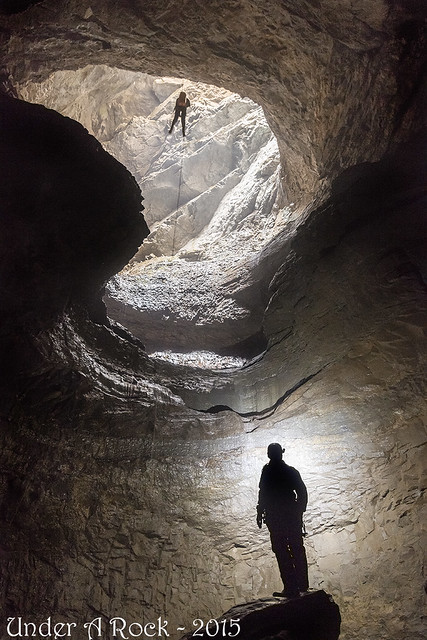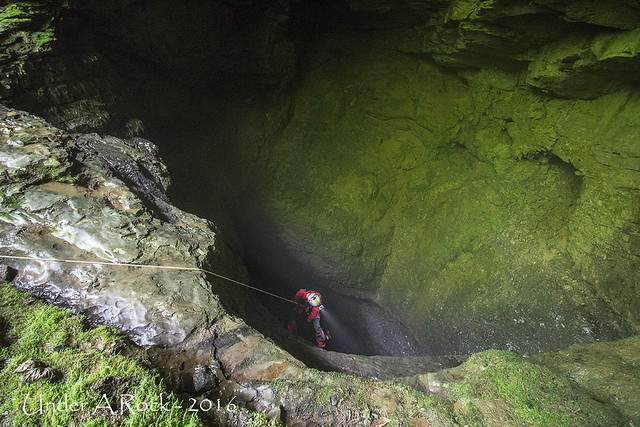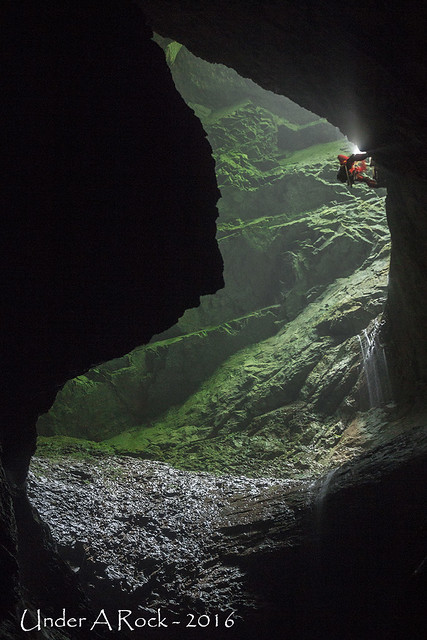 | ||
| Steph Petri (bottom) and Elliot Guerra-Blackmer in Crookshank Pit, October 2015 |
Crookshank Pit was one of the first known sections of what would become the Friars Hole Cave System, along with the Snedegars Cave area. Crookshank Pit lies just over the border in Greenbrier County and drains a large part of the valley south of Snedegars, pirating the stream into a sink hole that takes up the entire width of the valley. Crookshank lies within the northern wall of the sink, which measures roughly 50ft by 60ft and is 10-40ft deep. The top of the pit is very large, about 30ft in diameter, and has a very long and slippery lip. Do not approach the lip without a rope. Another point of caution (or warning) about Crookshank: the water levels are highly variable and can flash. I have personally been in the pit for one flood and at the top for two. Do not do the pit in wet weather unless properly equipped. Further, the stream mostly sinks before the pit before bursting out of cracks in the wall. Do not trust the amount of water flowing over the lip to be an accurate representation of the water levels! Also Crookshank is a cold air sink, and in the winter winds carrying frigid outside air howl through the pit.
 |
| Tyler Anderson at the lip of Crookshank Pit, Memorial Day 2016 |
Rigging point is commonly the tree with the "Caution: Rats May Chew Your Rope!" sign. An old rebelay bolt is on the final ledge before the free drop. The drop is roughly 95ft total, with the first 15ft being on the wall and the final 80ft being very free in the middle of a large canyon passage. With a waterfall cascading in, few entrances in West Virginia match Crookshank for beauty. In the summer, moss growing on the alcove makes the whole pit glow a bright emerald green.
 |
| Tyler Anderson in Crookshank Pit, Memorial Day 2016. |
From the bottom of the pit the stream follows a large canyon passage leads for about a hundred feet before dropping to a belly and army crawl. Off shooting lead to areas like the Baltimore Dome Complex, and Crap Canyon. The stream sumps (or sinks) right before a low pinch. This area has been known to flood completely or fill with dirt. Cavers had to dig it open back in the 50s to find the rest of the cave. From here the passage forks. Right takes one through the (sometimes passable) 400ft long Terrible Crawl to the Promised Land. Left takes one through a hands and knees crawl for several hundred feet before emerging in the Crookshank Stream passage.
From the junction with the stream: going down stream quickly leads to a sump. Going upstream leads through large and pleseant stream-borehole. Fully 20ft wide and 40ft tall, the clean washed borehole, with its deep blue plunge pools, is one of the more beautiful stream passages in the cave. The borehole ends at a two-tiered 10ft waterfall. There are multiple ways up, most require getting very wet. Above the waterfall the stream can be followed for several hundred feet to the Snedegars Sump, who's passing connected Crookshank and Snedegars in the 1960s - the first in the system.
Above the waterfall a passage to the right leads through the Sloppy Crawl and into the Promised Land Passage. The Promise Land continues as crawling and walking for several hundred feet, past a junction with the Terrible Crawl and ends in a room full of breakdown where the first connection with Rubber Chicken is. Also out here is the long, narrow, and strenuous Lew's Last Climb Passage which goes south for almost a thousand feet.
No comments:
Post a Comment